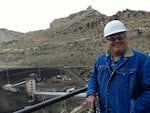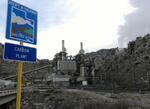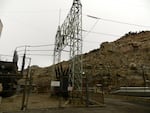
Kyle Davis worked his way up to director of PacifiCorp's Carbon Plant. The company has decided the 60-year-old plant will retire before he does.
Cassandra Profita
Northwest utilities are fighting pressure to end to all use of coal-fired power -- even when it's generated in places like Utah and Montana.
Many people are surprised to find out how much coal-fired power the Northwest still uses, even with all of its hydroelectric dams and wind farms. Oregon still gets about a third of its electricity from coal. In Washington, it's about 15 percent.
And while the two coal plants based in Oregon and Washington are both scheduled to close – Eastern Oregon's Boardman plant in 2020 and Eastern Washington's Centralia plant in 2025 – that won't mean the end of coal-fired power in the two states. Both states have utilities that get some of their power from out-of-state coal plants.
Take PacifiCorp's Carbon Plant, where Kyle Davis has worked for the past 39 years.

The coal-fired Carbon Plant was closed by Portland-based PacifiCorp.
Cassandra Profita
It’s one of 10 plants in the Rocky Mountain region Portland-based PacifiCorp uses to generate electricity for customers in six western states, including Oregon and Washington. It's in the heart of coal country, and it's named accordingly: It's located in Carbon County, Utah – a county named after its many coal deposits.
Times are hard for the plant and county named after coal. PacifiCorp is closing the Carbon Plant this month. That means the plant where Davis has worked for most his life is going to retire before he does.
"The environmental regulations just keep tightening and there becomes more of them," Davis said. "The county's coal mines are in decline. Coal is not a very popular energy source anymore."
Coal is particularly unpopular with clean energy advocates in Oregon and Washington. They're pushing bills in both states' legislatures this session that would close more out-of-state coal plants with the goal of getting Northwest utilities off coal altogether. With more and more rules stacked against them, utilities are increasingly contemplating the end of coal-fired power and recognizing it may not be a matter of if but when.
Mounting Pressure On Coal
The Environmental Protection Agency has proposed new carbon regulations through the Clean Power Plan, which was designed to address climate change by reducing carbon dioxide emissions by 30 percent by 2030. But that's not what killed the Carbon Plant. It was a different set of EPA rules on mercury and other toxic air pollutants.
PacifiCorp is also contending with EPA limits on nitrogen oxide and sulfur dioxide pollution, a rule designed to reduce haze in wilderness areas and national parks. In the past eight years, the company has spent more than a billion dollars on pollution controls to keep its coal plants running amid a barrage of EPA regulations.

EPA regulations are leading to more coal plant closures.
Cassandra Profita
But shutting down the Carbon Plant was more cost-effective than upgrading. That's the case with more and more coal plants as regulations add to the cost of operations. In its latest 20-year plan, finalized last month, PacifiCorp told regulators it will stop burning coal in about half of its coal operations in the next 20 years. The company currently gets about two-thirds of its power from coal. It plans to shrink that to less than one-third by 2034.
"We see a transition away from coal," said Rick Link, who helped develop PacifiCorp's latest long-term plan. "We know that is the likely future not only for PacifiCorp but perhaps across the country. The way we see it, we're going to get there, we just need to do it in the most cost-effective way possible."
Couple the existing EPA rules with the proposed Clean Power Plan, and a whole lot of utilities start wondering whether they'll have coal in their future at all.

Portland General Electric's coal-fired Boardman Power Plant. It closed on Oct. 15, 2020.
Courtesy Portland General Electric
Kimberly Harris, CEO of Washington's Puget Sound Energy, appeared at a conference of utility regulators last year. She spoke the day after the EPA released its draft Clean Power Plan.
"So, what is the future of coal?" she asked the gathering. "It's complex. It's uncertain. It's transitional."
Puget Sound Energy still relies on a coal plant in Montana for about a quarter of its power. Harris said the transition away from coal needs to be be slow and careful to avoid disrupting the power supply and raising the price of electricity.
Some people may think the EPA's Clean Power Plan will mean utilities just have to shut all the coal plants down, she said, but that's not going to work.
"You can't just shut down all the coal units and expect for the grid to continue to operate," she said.
Cutting Off Coal Power Transmissions
But some in the Northwest say a total coal shutdown is what the planet needs. Amy Hojnowski of The Sierra Club said it's great that the two coal-fired power plants in Boardman, Oregon, and Centralia, Washington are scheduled to close by 2020 and 2025, respectively.

Transmission lines deliver coal-fired power from plants in the Rocky Mountain region.
"The next step is really looking at what are we doing about all the coal we're using from out-of-state resources," she said. "And saying, 'What can we do to get truly coal free?'"
Her group is turning to the Washington and Oregon legislatures. It’s pushing bills in both states that aim to close the coal plants in Montana, Wyoming and Utah that send power to the Northwest via transmission wires.
In Washington, Senate Bill 5874 was originally designed to spur Puget Sound Energy to close the Colstrip Plant in Montana. It's been replaced with a bill that calls for studying the costs and benefits of retiring coal plants.
But Bill Arthur of the Sierra Club said his group is now in discussions with Puget Sound Energy on a different proposal that would allow Puget Sound Energy to buy out other interests in the Colstrip Plant so the utility could eventually close it down. Arthur said a huge portion of the coal-fired power coming into Washington state right now comes from Colstrip.

The coal-fired plant in Centralia, Wash. was the Northwest's top greenhouse gas polluter in 2010, emitting nearly 10 million metric tons of carbon dioxide, according to the EPA.
Robert Ashworth/Flickr
"If we can reach an agreement, it has the potential to be legislation that can be passed this year," he said.
In Oregon, Senate Bill 477 would put an expiration date of 2025 on all coal-fired power coming into the state and would require utilities to replace electricity from coal with power that is 90 percent cleaner.
Bob Jencks, executive director of the Oregon Citizens Utility Board, said he supports the bill in part because it will help save utility customers money in the long run, as carbon regulations ramp up.
"If you don't do anything, PacifiCorp's customers are going to get hammered by carbon regulation," he said. "We think the added costs of this bill are almost identical to the savings in carbon costs."
But utilities say the bill wouldn't necessarily close out-of-state coal plants; it would, they contend, raise the cost of electricity for their customers in Oregon who wouldn't be getting the cheaper power from coal plants.
"This legislation is simply not ready for prime time," Scott Bolton, director of government affairs for PacifiCorp, said at a recent hearing. "It uniquely focuses costs on Oregonians in a way that's more painful than is necessary. The grid is regional by nature, and Oregon is not going to be able to close coal plants in other states, just like other states are not going to be able to remove dams in Oregon."
